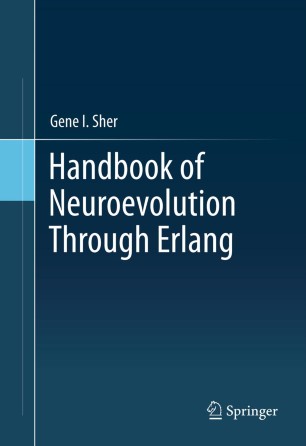By Gene I. Sher
Released: 2013Handbook of Neuroevolution Through Erlang presents both the theory behind, and the methodology of, developing a neuroevolutionary-based computational intelligence system using Erlang. With a foreword written by Joe Armstrong, this handbook offers an extensive tutorial for creating a state of the art Topology and Weight Evolving Artificial Neural Network (TWEANN) platform. In a step-by-step format, the reader is guided from a single simulated neuron to a complete system. By following these steps, the reader will be able to use novel technology to build a TWEANN system, which can be applied to Artificial Life simulation, and Forex trading. Because of Erlang’s architecture, it perfectly matches that of evolutionary and neurocomptational systems. As a programming language, it is a concurrent, message passing paradigm which allows the developers to make full use of the multi-core & multi-cpu systems. Handbook of Neuroevolution Through Erlang explains how to leverage Erlang’s features in the field of machine learning, and the system’s real world applications, ranging from algorithmic financial trading to artificial life and robotics.
Looks interesting, but it’s kind of in a different price league to most Erlang books.
I thought the same Phil… and had a quick look on Amazon - it seems to have favourable reviews, here’s a snippet of the most liked review there:
Brilliant description of a partnership between neural networks, evolutionary computing, and Erlang
Although shockingly expensive, it was worth buying because it’s a synthesis of three of my favourite topics: Erlang, evolutionary computing, and neural nets. My ultimate motive is to create, if possible, a stock market investment system.
Sher gives a very nice description of neural networks, from first principles, making it easy to understand them. Although starting simple, he takes it to an advanced level, and gives loads of references for further study. Then he does the same for evolutionary computing, a way of solving complex problems when you maybe have no idea of where to start. The complex problem in this case is how to find the best parameters for your neural network.
If you want to build a neural net and optimise via evolutionary computing, you’ll need to do some hairy programming. It would be easy enough at small scale, but to solve large and meaningful problems you’ll probably need a set of powerful servers and distribute the workload…
Full review here: Brilliant description of a partnership between neural networks, evolutionary computing, and Erlang
If anyone has read it please share your thoughts with us ![]()
I had a look into this book. Can’t really say anything about it because I have an only very basic understanding of neural networks.
What’s interesting is, that the neurons are modeled by processes (each neuron=one process) !?
Code was very hard read for me, thanks to the combination of Times New Roman and Erlang syntax.
I can see a new topic coming, “What’s your preferred font for reading Erlang code?” ![]()
at Erlang Factory SF Bay Area 2013 he had a presentation “Neuroevolution Through Erlang - Gene Sher”:
(only started watching it … ![]() )
)
I bought the book quite some time ago, even with its high price tag.
What I really like about the book are the “presented” ideas, even with some topics only scratched on the surface. But this is also because of the target of the ideas: military, and financial market.
On the other hand, the code is hard to read. IMHO the code could be written better, like in more modern style, or use of some libraries.
Regarding the “font and style of reading” it reminded me of a discussion about two WPF books “some time ago”, one written by Charles Petzold (with everything in grey), and on the other hand Adam Nathan’s book with coloured text and pictures. For example check out this blog entry, where you can also “see” some presentations of both books: How Not To Write a Technical Book
IMHO this book is of “very special interest”, and I don’t regret to have it in my personal library.
But You should really have a look inside it, before You purchase it.
Almost done with the book. Agree with other comments that the code is a bit difficult to read. A bit sad that the code base hasn’t been updated in a decade. While the code does run (at least up to chapter 18), some of it for the flatland example (i.e. visor.erl) depends upon the now defunct gs module. Any leads on getting gs built and installed on top of the latest version of Erlang/OTP?

